Migration is one of the great forces of history. When people move in large numbers they sometimes rearrange not only their own lives but also places they leave and the places they settle. Americans have always been a moving people, coming from other places, moving to new places. Not only has the nation long attracted people from other nations, it also claims high rates of internal migration. This project explores a number of consequential migrations--Great Migrations--that helped reshape culture, politics, or economic structures. It has six units (see menu top), each with detailed information and interactive maps, charts, and data: (1) the
Great Migration of African Americans out of the South 1900-2000; the
reverse migration to the South 1970-2020; state by state Black migration histories (2) the enormously consequential
migrations of Latinx Americans, both from Latin America and inside the US (1850-2017); (3) the
diaspora of whites from the South to northern and western states; (4) the
Dust Bowl migration to California from Oklahoma and neighboring states in the 1930s. (5) In addition, we provide
migration histories for all fifty states showing decade-by-decade from 1850-2017 where residents have come from.
This site is based on published and unpublished work by James Gregory, Professor of History, University of Washington. It is part of the Civil Rights and Labor History Consortium of public history projects directed by Professor Gregory at the University of Washington.

Upwards of 7 million African Americans left the South during the 20th century, settling mostly in the big cities of the North and West. In doing so they transformed more than their own lives. This Great Migration transformed cities and set the foundations for reconstructions of race, politics, and even the regional balances of the nation.
 This section includes interactive maps and charts tracking the exodus from the South; another set detailing the "reverse migration" to the South since 1970; a third with state-by-state Black migration histories 1850-2020. Explore
This section includes interactive maps and charts tracking the exodus from the South; another set detailing the "reverse migration" to the South since 1970; a third with state-by-state Black migration histories 1850-2020. Explore
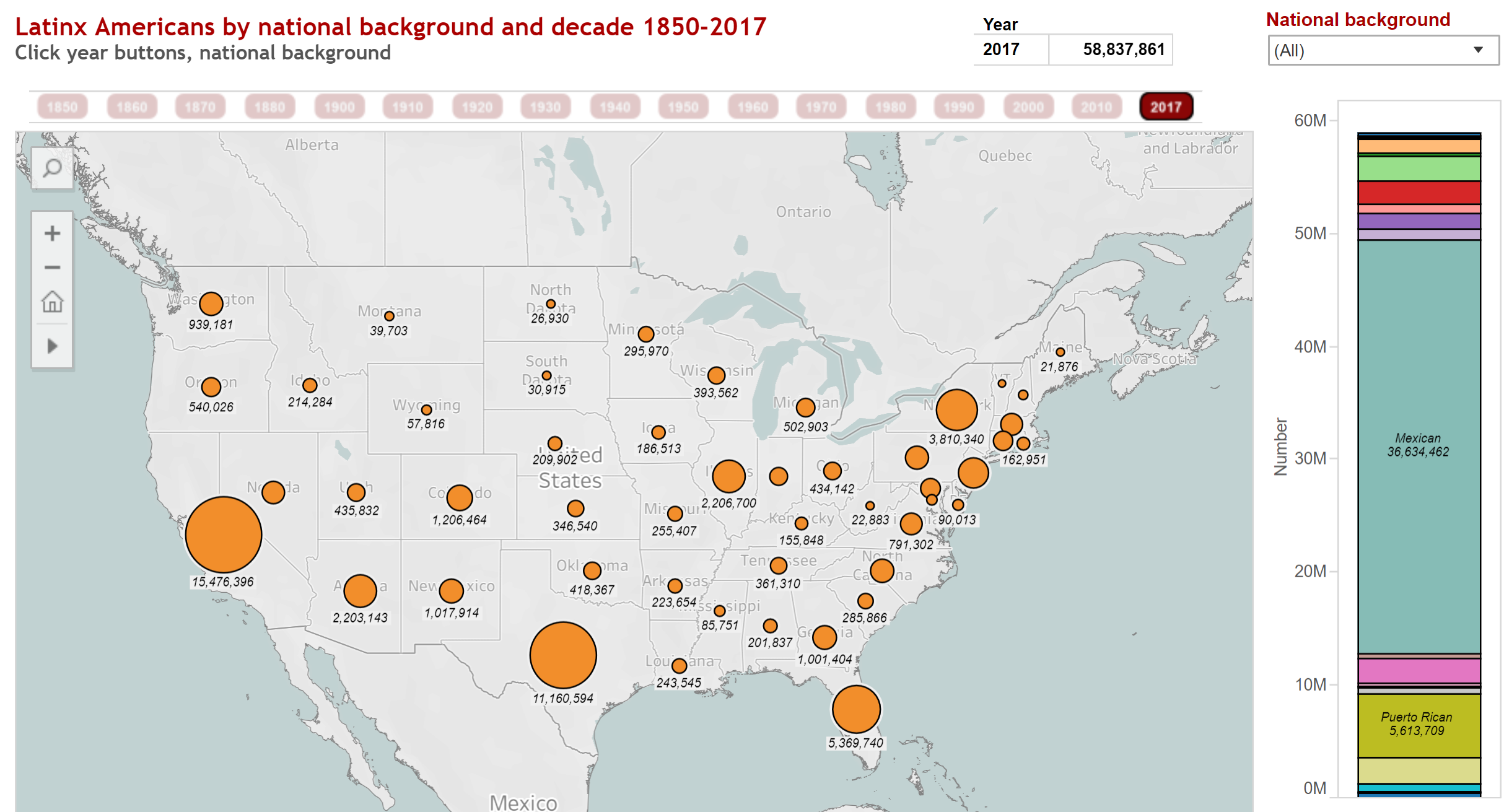
Spanish-speaking people were living in what is now the United States decades before English-speaking people crossed the Atlantic seeking colonies. Centuries later when the United States annexed Florida, Louisiana, and the northern half of Mexico, more than 100,000 Spanish-speaking residents became US citizens. The 1850 US census, taken shortly after the conquest of Mexico, counted more than 80,000 former Mexicans, 2,000 Cubans and Puerto Ricans, and another 20,000 people from Central and South America. Today the descendants of those 1850 citizens are part of a Latinx American population that has grown enormously. As of 2017, more than 58 million Americans claimed Latin American heritage. This section includes
six interactive maps and charts and a short interpretative essay.
Explore
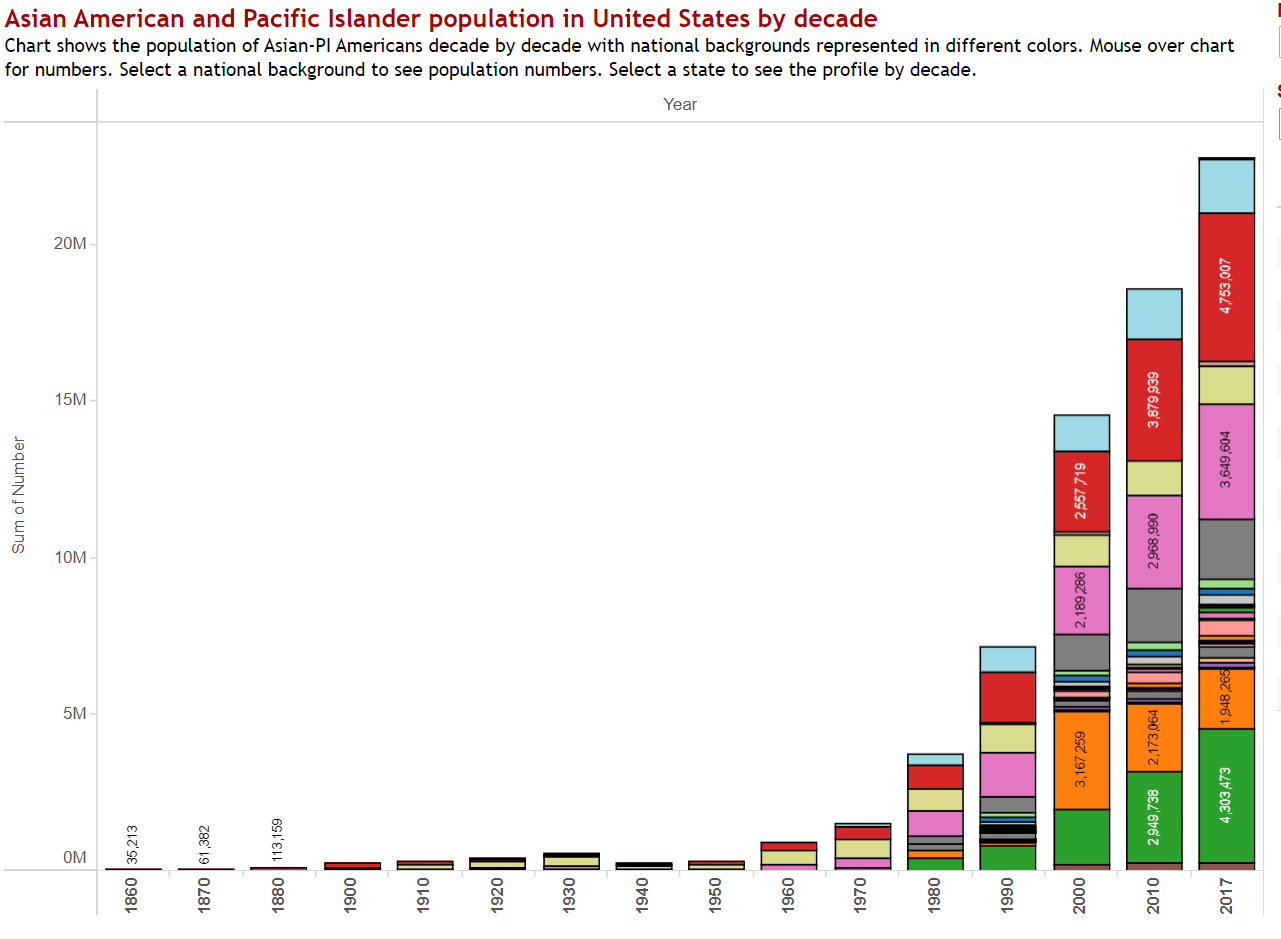
Chinese, Hawaiian, and Filipino mariners served on ships visiting the West Coast before the US seized the region in the 1840s, and Chinese migrants crossed the Pacific in large numbers starting with the California gold rush. But the 1882 Chinese Exclusion Act initiated a pattern of anti-Asian hysteria that would limit migration from all Asian nations for generations, until immigration laws changed in 1965. Since the 1970s, people have been coming to the US from every country in Asia and the Pacific, making Asian Americans one of the fast growing population sectors. This section reveals the complicated migration histories and distinctive geographies of Asian Americans and Pacific Islanders. Filters allow you to track people of each national background and explore populations state by state. This section includes
seven interactive maps and charts and a short interpretative essay.
Explore
 More than 20 million whites left the South during the 20th century, vastly outnumbering the 7-8 African Americans who left. They were joined by nearly 1 million Latinx, mostly Tejanos, who moved west to California and north into the Midwest.
More than 20 million whites left the South during the 20th century, vastly outnumbering the 7-8 African Americans who left. They were joined by nearly 1 million Latinx, mostly Tejanos, who moved west to California and north into the Midwest.
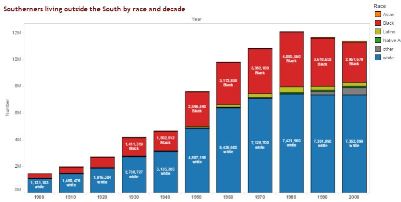 This section shows migration patterns and explores the impacts of the southern diaspora, including six interactive maps and tables as well interpretative essays. Explore
This section shows migration patterns and explores the impacts of the southern diaspora, including six interactive maps and tables as well interpretative essays. Explore
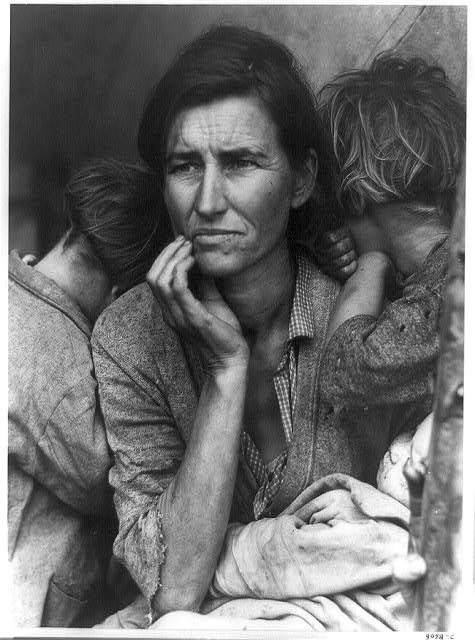
The relocation to California of close to 400,000 Oklahomans, Texans, Arkansans, and Missourians during the Great Depression was the most publicized mass migration of that decade. Many faced unexpected difficulties, especially those who headed for California's Central Valley.
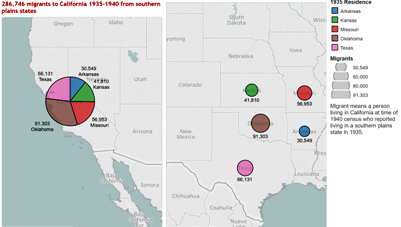 Their plight caught the attention of journalists, photographers, and became the subject of one of the most celebrated American novels of the century, John Steinbeck's The Grapes of Wrath. Here are three interactive maps as well as detailed accounts and primary sources. Explore
Their plight caught the attention of journalists, photographers, and became the subject of one of the most celebrated American novels of the century, John Steinbeck's The Grapes of Wrath. Here are three interactive maps as well as detailed accounts and primary sources. Explore

Americans have always been a moving people, coming from other places, moving to new places. Not only has the nation long attracted people from other nations, it also claims high rates of internal migration. Here are interactive graphics and maps that allow us to track the changing population decade-by-decade since 1850. Select a state and see where people were born, both other countries and other states. Select a race category. Move through the decades. Below are special pages for selected states. Explore.
 California's history is keyed to migration. The most populous state in the union became so because so many people from other states and other lands have moved there. It was not until 2010 that the number of native-born Californians surpassed the number who had migrated from somewhere else. And still today most adults are from another state or another country. Migration predated the period of US control notably when Spain sent soldiers and missionaries into the area they named California. It accelerated after the United States seized the Mexican province and immediately profited from the 1848 discovery of gold in the Sierra foothills. [more]
California's history is keyed to migration. The most populous state in the union became so because so many people from other states and other lands have moved there. It was not until 2010 that the number of native-born Californians surpassed the number who had migrated from somewhere else. And still today most adults are from another state or another country. Migration predated the period of US control notably when Spain sent soldiers and missionaries into the area they named California. It accelerated after the United States seized the Mexican province and immediately profited from the 1848 discovery of gold in the Sierra foothills. [more]
Florida Migration History 1850-2018
 More than any other southern state, Florida has consistantly attracted newcomers. Today only about one third of the population claims a Florida birthplace; two thirds are from somewhere else, many from Cuba and Latin America but really from every state and most nations. Migration to Florida is an old story, In the late 1800s, Florida grew rapidly as whites from neighborhing states moved south looking for land to farm. [more]
More than any other southern state, Florida has consistantly attracted newcomers. Today only about one third of the population claims a Florida birthplace; two thirds are from somewhere else, many from Cuba and Latin America but really from every state and most nations. Migration to Florida is an old story, In the late 1800s, Florida grew rapidly as whites from neighborhing states moved south looking for land to farm. [more]
Illinois Migration History State 1880-2018
 Illinois, like other midwestern states, experienced rapid population growth through migration in the 19th century and much slower growth since then. Recording a population of 851,000 in 1850, the state doubled its numbers by 1860, doubled again by 1880, and again before 1910. It has taken a century to double the 1910 total. Migration in the 19th century drew heavily on states to the east of Illinois, especially New York, Ohio, and Pennsylvania. European immigrants from Gemany and Ireland came in huge numbers in the same period. The 1880 census showed that roughly half the population were from out of state with Germany, New York, Ohio, and Ireland the leading contributors. [more]
Illinois, like other midwestern states, experienced rapid population growth through migration in the 19th century and much slower growth since then. Recording a population of 851,000 in 1850, the state doubled its numbers by 1860, doubled again by 1880, and again before 1910. It has taken a century to double the 1910 total. Migration in the 19th century drew heavily on states to the east of Illinois, especially New York, Ohio, and Pennsylvania. European immigrants from Gemany and Ireland came in huge numbers in the same period. The 1880 census showed that roughly half the population were from out of state with Germany, New York, Ohio, and Ireland the leading contributors. [more]
New York Migration History 1850-2018
 New York has always been the gateway state, the state that absorbs the greatest diversity of newcomers from abroad. In 1850 when for the first time the US census recorded birthplaces, the leading birthplaces for residents not born in New York were in order: Ireland, Germany, England, Connecticut, Massachusetts, Vermont, New Jersey, and Canada, with a dozen other countries further down the list. [more]
New York has always been the gateway state, the state that absorbs the greatest diversity of newcomers from abroad. In 1850 when for the first time the US census recorded birthplaces, the leading birthplaces for residents not born in New York were in order: Ireland, Germany, England, Connecticut, Massachusetts, Vermont, New Jersey, and Canada, with a dozen other countries further down the list. [more]
Texas Migration History 1850-2018
 Texas has been a migration magnet throughout its history, which helps explain the record of growth that now makes it the second most populous state following California. Migration, most of it illegal, from Tennessee, Alabama, and Mississippi fueled the rebellion that wrestled the province from Mexico in 1836. In the decades that followed an enormous number of southerners moved west to expand the cotton belt, many of them enslaved. [more]
Texas has been a migration magnet throughout its history, which helps explain the record of growth that now makes it the second most populous state following California. Migration, most of it illegal, from Tennessee, Alabama, and Mississippi fueled the rebellion that wrestled the province from Mexico in 1836. In the decades that followed an enormous number of southerners moved west to expand the cotton belt, many of them enslaved. [more]
Washington Migration History 1850-2018
 Washington remains today a state where most residents came from somewhere else, another state or another country. Occupied by Americans since the 1840s, it's population grew slowly until statehood in 1889, then surged after the discovery of gold in Alaska and the Yukon in 1896. Farming, timber, and fishing attracted newcomers from the upper Midwest and from northern Europe, along with smaller numbers of Chinese and Japanese. [more]
Washington remains today a state where most residents came from somewhere else, another state or another country. Occupied by Americans since the 1840s, it's population grew slowly until statehood in 1889, then surged after the discovery of gold in Alaska and the Yukon in 1896. Farming, timber, and fishing attracted newcomers from the upper Midwest and from northern Europe, along with smaller numbers of Chinese and Japanese. [more]
Arizona Migration History 1850-2018
 Arizona remains today a state where most residents came from somewhere else, either another state or another country. It is also a state where substantial tracts of land remain the property of Native nations--Navaho, Yuma, Pima, Apache, Pueblo, Papago, and Zuni. The United States seized the area in the war against Mexico in 1846, but few Americans found reason to settle there until silver and cooper deposits brought miners starting in the late 1870s. An 1870 population of less than 10,000 grew to 122,000 by 1900. Whites comprised less than half of the turn-of-the-century population. One third were ethnic Mexicans, born either in the Southwest or Mexico. Native peoples accounted for more than 20 percent of persons enumerated in the 1900 census. [more]
Arizona remains today a state where most residents came from somewhere else, either another state or another country. It is also a state where substantial tracts of land remain the property of Native nations--Navaho, Yuma, Pima, Apache, Pueblo, Papago, and Zuni. The United States seized the area in the war against Mexico in 1846, but few Americans found reason to settle there until silver and cooper deposits brought miners starting in the late 1870s. An 1870 population of less than 10,000 grew to 122,000 by 1900. Whites comprised less than half of the turn-of-the-century population. One third were ethnic Mexicans, born either in the Southwest or Mexico. Native peoples accounted for more than 20 percent of persons enumerated in the 1900 census. [more]
Colorado Migration History 1850-2018
 Colorado remains today a state where most residents came from somewhere else, either another state or another country. Cheyenne, Shoshone, Arapahoe, Ute, and other native nations commanded the area until 1848 when the United States seized it in its war against Mexico. The discovery of gold near Pike's Peak in 1857 set up the first significant influx of newcomers, mostly whites from Midwestern and Northeastern states. [more]
Colorado remains today a state where most residents came from somewhere else, either another state or another country. Cheyenne, Shoshone, Arapahoe, Ute, and other native nations commanded the area until 1848 when the United States seized it in its war against Mexico. The discovery of gold near Pike's Peak in 1857 set up the first significant influx of newcomers, mostly whites from Midwestern and Northeastern states. [more]
Virginia Migration History 1850-2018
 Until World War II, Virginia shared the demographic and migration patterns common to Southeastern states. The state attracted few newcomers aside from those moving short distances across the borders of continguous states. Natural increase among African American and white Virginians drove population gains while outmigration exceeded all avenues of inmigration.
World War II brought military installations and defense industries that began to reshape the economy,[more]
Until World War II, Virginia shared the demographic and migration patterns common to Southeastern states. The state attracted few newcomers aside from those moving short distances across the borders of continguous states. Natural increase among African American and white Virginians drove population gains while outmigration exceeded all avenues of inmigration.
World War II brought military installations and defense industries that began to reshape the economy,[more]
Alabama Migration History 1850-2018
 Alabama was a population replacement zone in the early 19th century as Choctaw, Creek, Chickisaw, and Cherokee people were driven west and their lands were sold off to White planters from Georgia, South and North Carolina, Tennessee, and Virgina bent on expanding the cotton kingdom. Enslaved people of African descent did the work and comprised 45 percent of Alabama's population on the eve of the Civil War. Freedom turned Alabama in a different direction. For the next century, until 1960s, few people moved into the state and population grew slowly, largely dependent upon "natural increase," an odd euphemism for the work of mothers. [more]
Alabama was a population replacement zone in the early 19th century as Choctaw, Creek, Chickisaw, and Cherokee people were driven west and their lands were sold off to White planters from Georgia, South and North Carolina, Tennessee, and Virgina bent on expanding the cotton kingdom. Enslaved people of African descent did the work and comprised 45 percent of Alabama's population on the eve of the Civil War. Freedom turned Alabama in a different direction. For the next century, until 1960s, few people moved into the state and population grew slowly, largely dependent upon "natural increase," an odd euphemism for the work of mothers. [more]
Alaska Migration History 1850-2018
 Alaska is the original migration state. Most scholars believe that humans first crossed from Asia into the American continents via the Berring land bridge to Alaska. Thousands of years later, the United States bought the region from Russia in 1867 without the knowledge or permission of the actual Alaskans. Three decades later in 1896, reports of gold in the Klondike region in Canada's Yukon triggered a rush of White Americans. The census of 1900 provides some data about the population and its origins. That 1900 count registered about 29,000 Alaska Natives along with about 35,000 people born elsewhere, mostly the United States but also Sweden, China, Canada, and Great Britain. [more]
Alaska is the original migration state. Most scholars believe that humans first crossed from Asia into the American continents via the Berring land bridge to Alaska. Thousands of years later, the United States bought the region from Russia in 1867 without the knowledge or permission of the actual Alaskans. Three decades later in 1896, reports of gold in the Klondike region in Canada's Yukon triggered a rush of White Americans. The census of 1900 provides some data about the population and its origins. That 1900 count registered about 29,000 Alaska Natives along with about 35,000 people born elsewhere, mostly the United States but also Sweden, China, Canada, and Great Britain. [more]
Oregon Migration History 1850-2018
 Oregon was the first of the West Coast territories to be claimed and occupied in force by the United States. White Americans began moving overland into the region in the 1830s intent on wrestling the land from its first peoples. After 1846, when Great Britain and the United States settled their competing claims to a vast Pacific Northwest region the flow of migrants along the Oregon trail increased. That route, starting in the Midwest and adjusted for different transportation systems, has been key to Oregon's population growth ever since. Unlike its West Coast cousins--California and Washington--Oregon's migration history has, until recently, involved newcomers who were mostly White, mostly US born, indeed mostly from the Midwest. [more]
Oregon was the first of the West Coast territories to be claimed and occupied in force by the United States. White Americans began moving overland into the region in the 1830s intent on wrestling the land from its first peoples. After 1846, when Great Britain and the United States settled their competing claims to a vast Pacific Northwest region the flow of migrants along the Oregon trail increased. That route, starting in the Midwest and adjusted for different transportation systems, has been key to Oregon's population growth ever since. Unlike its West Coast cousins--California and Washington--Oregon's migration history has, until recently, involved newcomers who were mostly White, mostly US born, indeed mostly from the Midwest. [more]

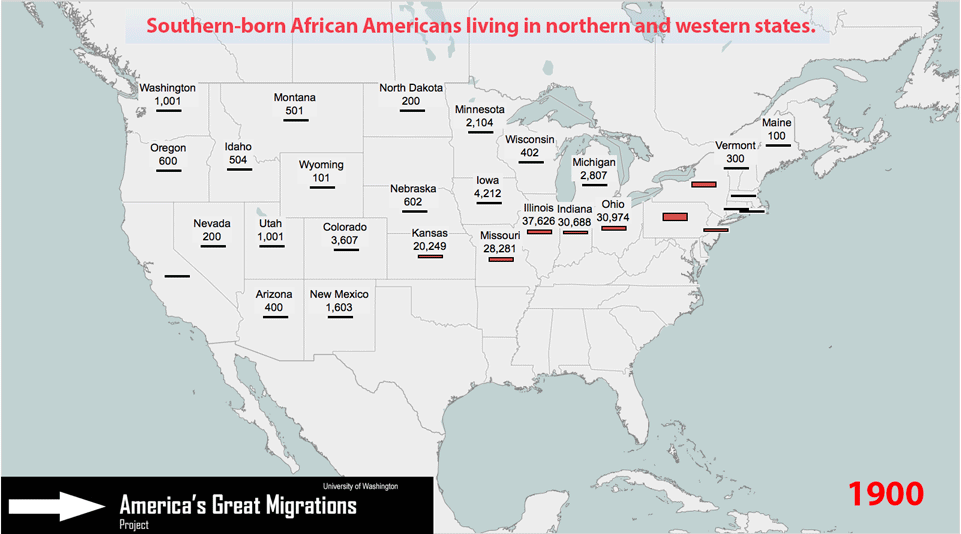
 Upwards of 7 million African Americans left the South during the 20th century, settling mostly in the big cities of the North and West. In doing so they transformed more than their own lives. This Great Migration transformed cities and set the foundations for reconstructions of race, politics, and even the regional balances of the nation.
Upwards of 7 million African Americans left the South during the 20th century, settling mostly in the big cities of the North and West. In doing so they transformed more than their own lives. This Great Migration transformed cities and set the foundations for reconstructions of race, politics, and even the regional balances of the nation.  Chinese, Hawaiian, and Filipino mariners served on ships visiting the West Coast before the US seized the region in the 1840s, and Chinese migrants crossed the Pacific in large numbers starting with the California gold rush. But the 1882 Chinese Exclusion Act initiated a pattern of anti-Asian hysteria that would limit migration from all Asian nations for generations, until immigration laws changed in 1965. Since the 1970s, people have been coming to the US from every country in Asia and the Pacific, making Asian Americans one of the fast growing population sectors. This section reveals the complicated migration histories and distinctive geographies of Asian Americans and Pacific Islanders. Filters allow you to track people of each national background and explore populations state by state. This section includes seven interactive maps and charts and a short interpretative essay.
Chinese, Hawaiian, and Filipino mariners served on ships visiting the West Coast before the US seized the region in the 1840s, and Chinese migrants crossed the Pacific in large numbers starting with the California gold rush. But the 1882 Chinese Exclusion Act initiated a pattern of anti-Asian hysteria that would limit migration from all Asian nations for generations, until immigration laws changed in 1965. Since the 1970s, people have been coming to the US from every country in Asia and the Pacific, making Asian Americans one of the fast growing population sectors. This section reveals the complicated migration histories and distinctive geographies of Asian Americans and Pacific Islanders. Filters allow you to track people of each national background and explore populations state by state. This section includes seven interactive maps and charts and a short interpretative essay.  More than 20 million whites left the South during the 20th century, vastly outnumbering the 7-8 African Americans who left. They were joined by nearly 1 million Latinx, mostly Tejanos, who moved west to California and north into the Midwest.
More than 20 million whites left the South during the 20th century, vastly outnumbering the 7-8 African Americans who left. They were joined by nearly 1 million Latinx, mostly Tejanos, who moved west to California and north into the Midwest. 

 California's history is keyed to migration. The most populous state in the union became so because so many people from other states and other lands have moved there. It was not until 2010 that the number of native-born Californians surpassed the number who had migrated from somewhere else. And still today most adults are from another state or another country. Migration predated the period of US control notably when Spain sent soldiers and missionaries into the area they named California. It accelerated after the United States seized the Mexican province and immediately profited from the 1848 discovery of gold in the Sierra foothills.
California's history is keyed to migration. The most populous state in the union became so because so many people from other states and other lands have moved there. It was not until 2010 that the number of native-born Californians surpassed the number who had migrated from somewhere else. And still today most adults are from another state or another country. Migration predated the period of US control notably when Spain sent soldiers and missionaries into the area they named California. It accelerated after the United States seized the Mexican province and immediately profited from the 1848 discovery of gold in the Sierra foothills.  More than any other southern state, Florida has consistantly attracted newcomers. Today only about one third of the population claims a Florida birthplace; two thirds are from somewhere else, many from Cuba and Latin America but really from every state and most nations. Migration to Florida is an old story, In the late 1800s, Florida grew rapidly as whites from neighborhing states moved south looking for land to farm.
More than any other southern state, Florida has consistantly attracted newcomers. Today only about one third of the population claims a Florida birthplace; two thirds are from somewhere else, many from Cuba and Latin America but really from every state and most nations. Migration to Florida is an old story, In the late 1800s, Florida grew rapidly as whites from neighborhing states moved south looking for land to farm.  Illinois, like other midwestern states, experienced rapid population growth through migration in the 19th century and much slower growth since then. Recording a population of 851,000 in 1850, the state doubled its numbers by 1860, doubled again by 1880, and again before 1910. It has taken a century to double the 1910 total. Migration in the 19th century drew heavily on states to the east of Illinois, especially New York, Ohio, and Pennsylvania. European immigrants from Gemany and Ireland came in huge numbers in the same period. The 1880 census showed that roughly half the population were from out of state with Germany, New York, Ohio, and Ireland the leading contributors.
Illinois, like other midwestern states, experienced rapid population growth through migration in the 19th century and much slower growth since then. Recording a population of 851,000 in 1850, the state doubled its numbers by 1860, doubled again by 1880, and again before 1910. It has taken a century to double the 1910 total. Migration in the 19th century drew heavily on states to the east of Illinois, especially New York, Ohio, and Pennsylvania. European immigrants from Gemany and Ireland came in huge numbers in the same period. The 1880 census showed that roughly half the population were from out of state with Germany, New York, Ohio, and Ireland the leading contributors.  New York has always been the gateway state, the state that absorbs the greatest diversity of newcomers from abroad. In 1850 when for the first time the US census recorded birthplaces, the leading birthplaces for residents not born in New York were in order: Ireland, Germany, England, Connecticut, Massachusetts, Vermont, New Jersey, and Canada, with a dozen other countries further down the list.
New York has always been the gateway state, the state that absorbs the greatest diversity of newcomers from abroad. In 1850 when for the first time the US census recorded birthplaces, the leading birthplaces for residents not born in New York were in order: Ireland, Germany, England, Connecticut, Massachusetts, Vermont, New Jersey, and Canada, with a dozen other countries further down the list.  Texas has been a migration magnet throughout its history, which helps explain the record of growth that now makes it the second most populous state following California. Migration, most of it illegal, from Tennessee, Alabama, and Mississippi fueled the rebellion that wrestled the province from Mexico in 1836. In the decades that followed an enormous number of southerners moved west to expand the cotton belt, many of them enslaved.
Texas has been a migration magnet throughout its history, which helps explain the record of growth that now makes it the second most populous state following California. Migration, most of it illegal, from Tennessee, Alabama, and Mississippi fueled the rebellion that wrestled the province from Mexico in 1836. In the decades that followed an enormous number of southerners moved west to expand the cotton belt, many of them enslaved.  Washington remains today a state where most residents came from somewhere else, another state or another country. Occupied by Americans since the 1840s, it's population grew slowly until statehood in 1889, then surged after the discovery of gold in Alaska and the Yukon in 1896. Farming, timber, and fishing attracted newcomers from the upper Midwest and from northern Europe, along with smaller numbers of Chinese and Japanese.
Washington remains today a state where most residents came from somewhere else, another state or another country. Occupied by Americans since the 1840s, it's population grew slowly until statehood in 1889, then surged after the discovery of gold in Alaska and the Yukon in 1896. Farming, timber, and fishing attracted newcomers from the upper Midwest and from northern Europe, along with smaller numbers of Chinese and Japanese.  Arizona remains today a state where most residents came from somewhere else, either another state or another country. It is also a state where substantial tracts of land remain the property of Native nations--Navaho, Yuma, Pima, Apache, Pueblo, Papago, and Zuni. The United States seized the area in the war against Mexico in 1846, but few Americans found reason to settle there until silver and cooper deposits brought miners starting in the late 1870s. An 1870 population of less than 10,000 grew to 122,000 by 1900. Whites comprised less than half of the turn-of-the-century population. One third were ethnic Mexicans, born either in the Southwest or Mexico. Native peoples accounted for more than 20 percent of persons enumerated in the 1900 census.
Arizona remains today a state where most residents came from somewhere else, either another state or another country. It is also a state where substantial tracts of land remain the property of Native nations--Navaho, Yuma, Pima, Apache, Pueblo, Papago, and Zuni. The United States seized the area in the war against Mexico in 1846, but few Americans found reason to settle there until silver and cooper deposits brought miners starting in the late 1870s. An 1870 population of less than 10,000 grew to 122,000 by 1900. Whites comprised less than half of the turn-of-the-century population. One third were ethnic Mexicans, born either in the Southwest or Mexico. Native peoples accounted for more than 20 percent of persons enumerated in the 1900 census.  Colorado remains today a state where most residents came from somewhere else, either another state or another country. Cheyenne, Shoshone, Arapahoe, Ute, and other native nations commanded the area until 1848 when the United States seized it in its war against Mexico. The discovery of gold near Pike's Peak in 1857 set up the first significant influx of newcomers, mostly whites from Midwestern and Northeastern states.
Colorado remains today a state where most residents came from somewhere else, either another state or another country. Cheyenne, Shoshone, Arapahoe, Ute, and other native nations commanded the area until 1848 when the United States seized it in its war against Mexico. The discovery of gold near Pike's Peak in 1857 set up the first significant influx of newcomers, mostly whites from Midwestern and Northeastern states.  Until World War II, Virginia shared the demographic and migration patterns common to Southeastern states. The state attracted few newcomers aside from those moving short distances across the borders of continguous states. Natural increase among African American and white Virginians drove population gains while outmigration exceeded all avenues of inmigration.
World War II brought military installations and defense industries that began to reshape the economy,
Until World War II, Virginia shared the demographic and migration patterns common to Southeastern states. The state attracted few newcomers aside from those moving short distances across the borders of continguous states. Natural increase among African American and white Virginians drove population gains while outmigration exceeded all avenues of inmigration.
World War II brought military installations and defense industries that began to reshape the economy, Alabama was a population replacement zone in the early 19th century as Choctaw, Creek, Chickisaw, and Cherokee people were driven west and their lands were sold off to White planters from Georgia, South and North Carolina, Tennessee, and Virgina bent on expanding the cotton kingdom. Enslaved people of African descent did the work and comprised 45 percent of Alabama's population on the eve of the Civil War. Freedom turned Alabama in a different direction. For the next century, until 1960s, few people moved into the state and population grew slowly, largely dependent upon "natural increase," an odd euphemism for the work of mothers.
Alabama was a population replacement zone in the early 19th century as Choctaw, Creek, Chickisaw, and Cherokee people were driven west and their lands were sold off to White planters from Georgia, South and North Carolina, Tennessee, and Virgina bent on expanding the cotton kingdom. Enslaved people of African descent did the work and comprised 45 percent of Alabama's population on the eve of the Civil War. Freedom turned Alabama in a different direction. For the next century, until 1960s, few people moved into the state and population grew slowly, largely dependent upon "natural increase," an odd euphemism for the work of mothers.  Alaska is the original migration state. Most scholars believe that humans first crossed from Asia into the American continents via the Berring land bridge to Alaska. Thousands of years later, the United States bought the region from Russia in 1867 without the knowledge or permission of the actual Alaskans. Three decades later in 1896, reports of gold in the Klondike region in Canada's Yukon triggered a rush of White Americans. The census of 1900 provides some data about the population and its origins. That 1900 count registered about 29,000 Alaska Natives along with about 35,000 people born elsewhere, mostly the United States but also Sweden, China, Canada, and Great Britain.
Alaska is the original migration state. Most scholars believe that humans first crossed from Asia into the American continents via the Berring land bridge to Alaska. Thousands of years later, the United States bought the region from Russia in 1867 without the knowledge or permission of the actual Alaskans. Three decades later in 1896, reports of gold in the Klondike region in Canada's Yukon triggered a rush of White Americans. The census of 1900 provides some data about the population and its origins. That 1900 count registered about 29,000 Alaska Natives along with about 35,000 people born elsewhere, mostly the United States but also Sweden, China, Canada, and Great Britain.  Oregon was the first of the West Coast territories to be claimed and occupied in force by the United States. White Americans began moving overland into the region in the 1830s intent on wrestling the land from its first peoples. After 1846, when Great Britain and the United States settled their competing claims to a vast Pacific Northwest region the flow of migrants along the Oregon trail increased. That route, starting in the Midwest and adjusted for different transportation systems, has been key to Oregon's population growth ever since. Unlike its West Coast cousins--California and Washington--Oregon's migration history has, until recently, involved newcomers who were mostly White, mostly US born, indeed mostly from the Midwest.
Oregon was the first of the West Coast territories to be claimed and occupied in force by the United States. White Americans began moving overland into the region in the 1830s intent on wrestling the land from its first peoples. After 1846, when Great Britain and the United States settled their competing claims to a vast Pacific Northwest region the flow of migrants along the Oregon trail increased. That route, starting in the Midwest and adjusted for different transportation systems, has been key to Oregon's population growth ever since. Unlike its West Coast cousins--California and Washington--Oregon's migration history has, until recently, involved newcomers who were mostly White, mostly US born, indeed mostly from the Midwest.